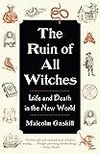
The Ruin of All Witches: Life and Death in the New World

“pandaemonium,” the capital of hell—was not demolished: it could only be starved of attention by people with fewer uses for magic than their parents and grandparents.
Malcolm Gaskill • The Ruin of All Witches: Life and Death in the New World
Puritan leadership in New England collapsed mainly from the franchise shifting from church membership to land ownership.
Malcolm Gaskill • The Ruin of All Witches: Life and Death in the New World
wherever self-interest took away from altruism, causing resentment, anxiety and a sense of guilt, witchcraft was apt to flourish,
Malcolm Gaskill • The Ruin of All Witches: Life and Death in the New World
Puritan zealots, they said, censured alleged heretics and witches without first searching their own hearts to see if the monstrosity that so frightened them actually lay there. Perhaps Satan made real monsters of the righteous by deceiving them into fighting imaginary ones.[4]
Malcolm Gaskill • The Ruin of All Witches: Life and Death in the New World
At the core of Pynchon’s contentiously offbeat interests was the doctrine of justification: how the Crucifixion had freed man from the curse of original sin. He
Malcolm Gaskill • The Ruin of All Witches: Life and Death in the New World
a shift from an enchanted world toward a world of enlightenment in which demons and specters vanished in the bright light of reason;
Malcolm Gaskill • The Ruin of All Witches: Life and Death in the New World
when every aspect of political, religious and economic existence was in turmoil throughout the Western world. Witches were tangible symbols of this chaos.
Malcolm Gaskill • The Ruin of All Witches: Life and Death in the New World
Always and everywhere, human beings have felt the radical inadequacy of their personal existence, the misery of being their insulated selves and not something else, something wider. —ALDOUS HUXLEY, THE DEVILS OF LONDUN, 1952, APPENDIX